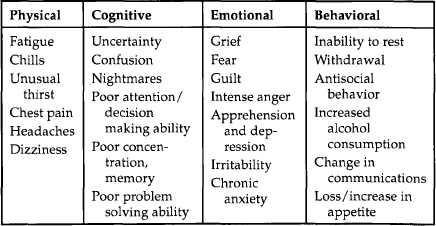6
Worker Safety Rules
6.1 Critical Incident Stress
6.1.1 Responding to Emergency Events
Workers responding to emergency events and or disasters will see and experience events that will strain their ability to function. These events, which include having to witness or experience tragedy, death, serious injuries and threatening situations are called “Critical Incidents.” The physical and psychological well-being of those experiencing this stress, as well as their future ability to function through a prolonged response, will depend upon how they manage this stress. Post traumatic stress disorder differs from critical incident stress by lasting longer than four weeks after the event triggering the emotional, mental or physical response. Most instances of critical incident stress last between two days and four weeks.
The signs and symptoms of critical incident stress can be physical, emotional, cognitive, or behavioral. Individuals express stress in different ways and therefore manifest different reactions. Table 6.1 below is not exhaustive but will help supervisors to identify workers who are exhibiting stress reactions.
Table 6.1 Signs and symptoms of stress.

During the emergency phase of the response, monitoring of employees by simple conversation and observation may help to identify early signs for some responders. The following steps can help to reduce significant stress detected ...

